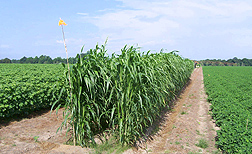Washington, DC, USA
November 5, 2014

Sorghum Sudan grass grown between peanuts (on right) and cotton (on left) reduces populations of stink bugs in cotton. Photo by Kristie Graham.
A U.S. Department of Agriculture (USDA) entomologist in Tifton, Georgia, has found a green alternative for controlling the stink bugs that attack crops in Georgia and in other states in the southeastern United States. The invasive brown marmorated stink bug is a familiar nuisance in many areas, but native brown stink bugs, green stink bugs and southern green stink bugs also damage crops in parts of the South.
Many farmers in Georgia plant corn each spring, then peanuts and then cotton, often near each other or side-by-side. The farmers control stink bugs with broad-spectrum insecticides, which kill not only stink bugs but also beneficial insects.
Patricia Glynn Tillman, who is with the Agricultural Research Service (ARS) Crop Protection and Management Research Unit, collected stink bugs from corn, peanut and cotton fields for 6 years and studied a number of strategies designed to control them. ARS is USDA's chief intramural scientific research agency, and this research supports the USDA priority of promoting sustainable agriculture.
In one study, Tillman and her colleagues placed nectar-producing buckwheat plants, sorghum Sudan grass (an annual grass that grows to about 8 feet), and two different-sized plastic sheets (about 6 feet high and about 2 feet high) between peanut and cotton fields. The grass and plastic sheets were introduced to see if they would prevent stink bugs from migrating from low-growing peanut plants into cotton. She found that the plastic and the grass were effective, as long as the barriers were at least as high as the cotton (4.5 feet). She also found that the buckwheat attracted Trichopoda pennipes, a beneficial insect that reduced the number of stink bugs in nearby cotton. Results were published September 1, 2014, in the Journal of Pest Science.
The researchers also placed potted milkweed plants along the edges of cotton fields in peanut/cotton production areas and sampled the cotton for stink bugs and T. pennipes. They found significantly higher numbers of T. pennipes parasitizing and controlling stink bugs near the nectar-producing milkweed. They also found that the milkweed attracted Monarch butterflies, an eye-catching migratory species that has prompted concern among conservationists because of the loss of milkweed habitats. Results were published April 1, 2014, in Environmental Entomology.
Read more about this work in the November/December 2014 issue of Agricultural Research magazine.